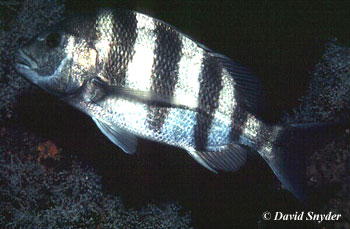
Archosargus probatocephalus
This flat, oval fish has dorsal and anal fins that are rounded towards the slightly forked caudal (tail) fin, and its greenish-silver body is striped with five or six dark vertical bars. It grows to almost 30 inches and 22 pounds eating invertebrates, small vertebrates, and some plants. They prefer inshore areas around jetties and piling, or in brackish waters around mangroves and estuaries. They are a prized food fish, and are also popular in public aquariums.
Order: Perciformes
Family: Sparidae
Genus: Archosargus
Species: probatocephalus
Common Names
Sheepshead, convict fish, sheephead, sheepshead seabream, and southern sheeps head are common English language names. Other common names include kubinskiy morskoi karas’ (Russian), rondeau mouton (French), sargo (Spanish), sargo chopa (Spanish), sargo-choupa (Portuguese), and sparus owczarz (Polish).
Importance to Humans
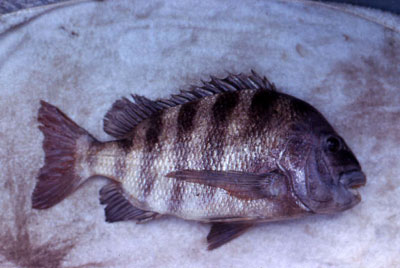
This fish is highly valued for human consumption due to its fine white flesh and mild flavor. However, its heavy scales and strong fin spines make it difficult to clean and fillet. It is marketed fresh and frozen and may be prepared by broiling, microwaving, and baking. Commercially, the majority of sheepshead are accidentally caught in shrimp trawlers and tossed back into the water, although some are taken intentionally. They may also be caught by longlines, seines, and trammel nets. Commercial catches of sheepshead have historically been largest off the gulf coasts of Florida, Texas, and Louisiana. Sheepshead are also collected for public show aquariums.
Conservation Status
Assessments of sheepshead populations based upon the number of recruits and catch yields have indicated that they have been at times over-harvested. Fishery management actions, including catch method restrictions, size limits, and bag limits, are credited with bringing about a decline in fishing mortality and a shift in age-specific vulnerability allowing for the increase in spawning stock in Florida. This fish is not listed as endangered or vulnerable with the World Conservation Union (IUCN). The IUCN is a global union of states, governmental agencies, and non-governmental organizations in a partnership that assesses the conservation status of species.
> Check the status of the sheepshead at the IUCN website.
Geographical Distribution
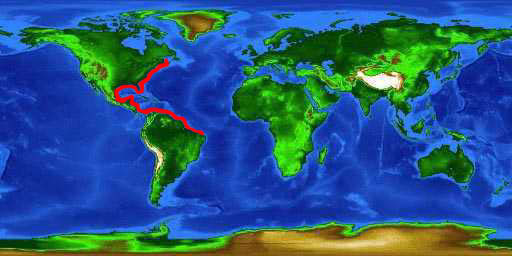
The distribution of the sheepshead in the western Atlantic Ocean includes coastal waters from Nova Scotia (Canada) through the Gulf of Mexico with the densest populations occurring off southwest Florida. Sheepshead are also found, albeit in much lesser numbers, off the Caribbean coasts of Central and South America, south to Brazil. Sheepshead are absent in the Bahamas, West Indies, Grenada, and Bermuda.
Habitat
Primarily occurring inshore around rock pilings, jetties, mangrove roots, and piers as well as in tidal creeks, the euryhaline sheepshead prefers brackish waters. It seeks out warmer spots near spring outlets and river discharges and sometimes enters freshwater during the winter months. This fish moves to offshore areas in later winter and early spring for spawning, which sometimes occurs over artificial reefs and navigation markers. Juveniles live in seagrass flats and over mud bottoms. Recorded among those species that perish during periodic low oxygen fish kills, the sheepshead is not particularly tolerant of low levels of dissolved oxygen.
Biology
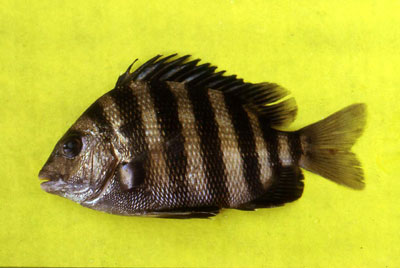
Distinctive Features
The sheepshead has an oval-shaped, deep body with a blunt snout and small, nearly horizontal mouth. The posterior nostril is slit-like in appearance. Dorsal and anal fins include stout, short spines. The second spine of the anal fin is enlarged. Pectoral fins are long, extending beyond the anal opening when appressed (pressed close to the body). The caudal fin is shallowly forked.
Coloration
The adult sheepshead is silvery to greenish-yellow with an olive back. There are five or six dark vertical crossbars along each side, which are most distinct in young individuals. The caudal and pectoral fins are greenish while the dorsal, anal, and ventral fins are dusky or black. Other fish that are similar in appearance to the sheepshead include the black drum (Pogonias cromis) and Atlantic spadefish (Chaetodipterus faber). However, the black drum has barbels on the lower jaw and reaches a much larger adult size than the sheepshead. The Atlantic spadefish has a very short snout, a much rounder body shape and a larger soft dorsal and anal fin than the sheepshead. Additionally, the vertical bands on the sides of the black drum and Atlantic spadefish tend to fade with age much more so than the markings of the sheepshead.
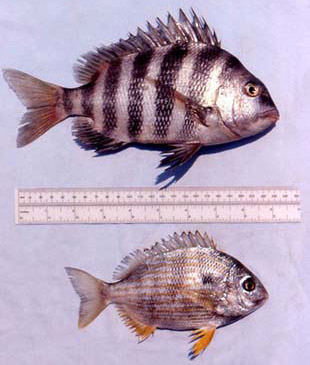
Dentition
Teeth of the sheepshead include well-defined incisors, molars, and grinders. At the front of the jaw are the incisor-like teeth. The molars are arranged in three rows in the upper jaw and two rows in the lower jaw. Heavy, strong teeth are necessary for crushing and grinding the shelled animals that are prey for this fish. Sheepshead lack tooth patches on the roof of the mouth.
Size, Age, and Growth
Although it reaches a maximum size of about 29.5 inches (76 cm) and 22 pounds (9.6 kg), adult sheepshead are most commonly about 1-8 pounds (.5-3.6 kg) and 14-18 inches (35 cm). Maximum known lifespan of the sheepshead is at least 20 years with maturity typically reached at 2 years of age.
Food Habits
The sheepshead is an omnivorous fish, feeding on invertebrates, small vertebrates and occasional plant material. Large juveniles and adults prey on blue crab, oysters, clams, crustaceans, and small fish including young Atlantic croakers (Micropogonias undulatus, Sciaenidae). The sheepshead uses its impressive dentition to crush heavily armored and shelled prey and to scrape barnacles from rocks and pilings. The diet of juveniles includes zooplankton, polychaetes, and chironomid (midges) larvae.
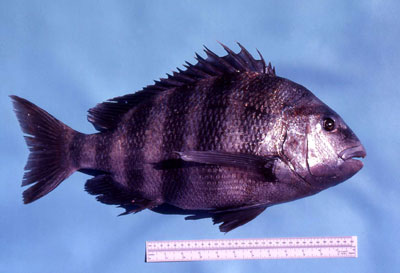
Reproduction
Populations of sheepshead in mid-Atlantic coastal waters and the Mississippi Sound spawn in primarily in the early spring although pelagic larvae have been recorded from January through May in the Gulf of Mexico. Adults migrate to offshore waters to spawn, later returning to nearshore waters and estuaries.Spawning frequency ranges from once a day to once every 20 days. Little is known regarding spawning behavior. Depending upon their condition, females may produce from 1,100 to 250,000 eggs per spawning event. One study determined that those fishes found closer to shore averaged 11,000 eggs per spawning event while those offshore averaged 87,000 eggs per batch. The buoyant eggs are approximately 0.8mm in diameter, hatching 28 hours following fertilization at 23°C. The larvae rely on the attached yolk sac at lengths of 2.0-4.5 mm. When the larvae reach 4mm in length, the caudal and anal fins are well developed. Pigmentation of the larval sheepshead is brownish with a median ventral line. Black spots are located behind the isthmus, base of the pectoral fin, and anterior to the anal fin. Two dark specks are also located at the base of the anal fin. Juvenile sheepshead (25-30mm) have a forked caudal fin, a lateral line and exhibit adult patterning. They are most abundant in seagrass flats and above mud bottoms, feeding on copepods and algae. At lengths of 50mm, the juveniles leave the grass flats and congregate with adults around jetties, piers, and pilings.
Predators
Sharks and other large piscivorous fishes feed on the sheepshead.
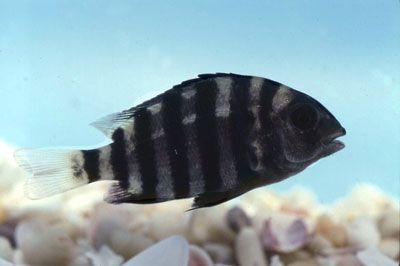
Parasites
The sheepshead is parasitized by a variety of organisms including ciliates, nematodes, trematodes, and isopods, none of which are known to pose a significant threat to populations of this fish.
Taxonomy
The sheepshead is a member of the porgy and seabream family (Sparidae), which is comprised of approximately 120 species distributed worldwide. The sheepshead was originally described by J.J. Walbaum in 1792 as Sparus probatocephalus. Recognizing the uniqueness of the sheepshead in comparison to other porgies, long time Smithsonian scientist Theodore Nicholas Gill erected the monotypic genus Archosargus in 1865. Today there are two valid species of Archosargus, the aforementioned A. probatocephalus (Walbaum 1792) and the sea bream, A.rhomboidalis (Linnaeus 1758). Synonyms of Archosargus probatocephalus include Sparus ovicephalus Bloch & Schneider 1801, Sargus aries Valenciennes 1830, Perca leonina Gronow 1854 and Archosargus oviceps Ginsburg 1952. A division of A. probatocephalus into three subspecies has been proposed: A. p. probatocephalus for the northern form occurring from Canada south to Cedar Key off the Florida gulf coast; A. p. oviceps in the Gulf of Mexico from St Marks, Florida to the Campeche Bank, Mexico; and A. p. aries ranging from Belize to Brazil.
Prepared by: Cathleen Bester and Robert H. Robins